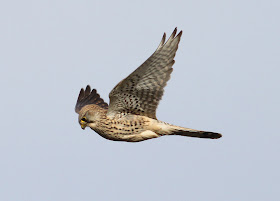It was very windy today, limiting my birding to topping up the feeders at Out Rawcliffe where despite the strong gusts I found a number of birds close to my ringing spot: 32 Goldfinch, 60+ Chaffinch and 8 Reed Buntings being a good sign that birds are coming back after my absence. Also about the site were 800 Woodpigeon, 350 Lapwing and at least 2500 Pink-footed Goose. I left the geese in peace, not wanting to put them to flight into the path of shooters on the next farm. On my way off the farm one of the local Kestrels hung into the wind above the track, living up to its old English name of Windhover.
Common Kestrel
Common Kestrel
In the absence of more local news and to fill out today’s post I put together more images from the recent holiday in the Canary Islands, Spain.
Although holding a certain attraction, the beaches of Fuerteventura weren’t the sole interest in our recent holiday. A hire car for a few days gave a chance to explore the island although at approximately 650 square miles there’s a lot of ground to cover, and a pure white car isn’t the best colour for approaching cautious birds.
Remember to "Click the pics" for a close-up tour of the birds and the island.
The plains above Costa Calma and La Pared hold Houbara Bustards, Cream-coloured Coursers and Stone Curlew, but in a couple of tries we didn’t have much luck apart from 3 distant Stone Curlew and brief views of a running Courser.
There were lots of Lesser Short-toed Larks on the dry, open plains with small gangs of Linnets and occasional Southern Grey Shrikes. The Linnets are very unapproachable, as are the Goldfinches that can be glimpsed in greener parts of the island.
We journeyed through the centre of the island through the village of Betancuria and on to the highest parts of the island at 600 meters, giving a spectacular outlook on the landscape below and distant views of an Egyptian Vulture. This species is apparently now rare on the island as they are elsewhere in its range and we had just two sightings of the vulture in two weeks.
A walk exploring the outskirts and the village of Betancuria provided Sardinian Warbler, Blackcap, Chiffchaff, Kestrel, African Blue Tit, Spectacled Warbler and Trumpeter Finch. The latter three were all new birds for me with the wary Trumpeter Finch a particular favourite, due to its slightly comical appearance.
Trumpeter Finch
A few Spectacled Warblers were in song, and I guess the breeding season is quite early in these parts.
The so named Canary Islands Stonechat is actually found on Fuerteventura only where it is said to be best found in the dried up river beds, the barrancos, dotted around the island. I found them in a couple of locations where houses ran down to the beach, one time finding one feeding on the tide wrack with Berthelot’s Pipits, until I disturbed it whereupon it flew chat-like to the nearby fence. To me they appeared much like a very dark-headed Whinchat rather than a Stonechat.
Berthelot's Pipit
Berthelot's Pipit
Canary Islands Stonechat - By Frank Vassen [CC-BY-2.0 (http://creativecommons.org/licenses/by/2.0)], via Wikimedia Commons
Exploring Fuerteventura
More from Fuerteventura soon, and hopefully a little local birding and ringing too.





















Hello Phl,estupendas capturas.Un abrazo
ReplyDeleteAmazing shots once again. The kestrel and spectacled warbler are standouts for me. What a great day!
ReplyDelete"Windhover" - what a great name for the Kestrel!
ReplyDeleteThank you for the island tour. Great images of birds I've never seen! The Courser is pretty sleek looking. He looks like a fast runner.
These are so cool. I'm so glad you're sharing these shots. It's a big possibility that I'll be back there again within the next 10 years. That cousier is spectacular and the Kestrel is so different from our own. Thanks for sharing your journeys.
ReplyDeleteYour flight/hovering Kestrel images are awesome and that Shrike...what a handsome face and then along with all of your images, one that stands out for me is the little...I am guessing it is little...Spectacled Warbler...what a sweetheart of a bird, gorgeous feathers, face and eye~
ReplyDeleteSome great pics there Phil, my fave is the Spectacled Warbler........
ReplyDeleteI like the Windhover images. The vulture must have been quite an encounter.
ReplyDeleteHi Phil; Glad you enjoyed your break ,brilliant shots as usual & descriptive summary All the best JWB.
ReplyDeleteA marvelous place for birding and gorgeous shots.
ReplyDeleteA feast of species, Phil. Kestrel shots are superb and love that spectacular warbler.
ReplyDeleteHi Phil, glorious postings and photos as always. Your blog is my favourite place to update myself on what is happening with British birds.
ReplyDelete